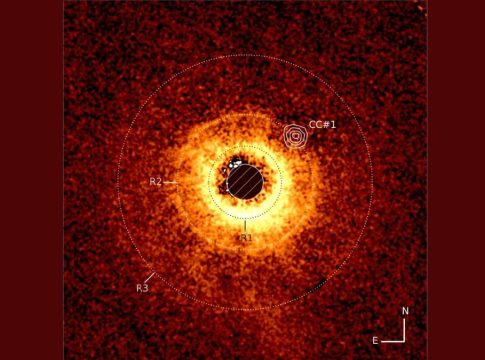James Webb Space Telescope Captures First Image of an Exoplanet
In a remarkable breakthrough, the James Webb Space Telescope (JWST) has achieved a milestone by directly imaging its first exoplanet—an exciting feat in the field of astronomy. TWA 7 b, a Saturn-mass planet, orbits the young star TWA 7, situated relatively close to us. This discovery not only expands our understanding of exoplanets but also ushers in a new era of direct imaging opportunities.
Unveiling TWA 7 b
With a mass approximately 30% that of Jupiter, TWA 7 b stands as the smallest exoplanet captured via direct imaging to date. Most of the nearly 6,000 exoplanets identified so far have been found through indirect methods. However, the JWST team employed a specialized coronagraph, similar to a solar eclipse, to obscure the light from TWA 7, allowing them to detect the faint presence of TWA 7 b.
Using its Mid-Infrared Instrument (MIRI), JWST focused on TWA 7, which boasts a dusty disk that is almost face-on to our view, detailing clear ring structures. After processing the captured data, astronomers identified a faint infrared point roughly 1.5 arcseconds away from TWA 7—about 50 times the distance from Earth to the Sun. This point lies within a gap of the star’s second dust ring and exhibits brightness and color characteristics consistent with theoretical models predicting a young, cold planet.
A Leap Towards Smaller Worlds
The significance of TWA 7 b extends beyond its mass; it represents a shift in the JWST’s capability to image much smaller planets than previously possible. The previous smallest planet captured through direct imaging was ten times more massive. This discovery sets the stage for the potential identification of even lighter celestial bodies—scientists speculate that future observations could reveal planets weighing as little as 10% of Jupiter’s mass.
Astronomers are optimistic; this initial success effectively "paves the way" for future missions that aim to capture images of Earth-like planets. Plans for next-generation telescopes—both terrestrial and space-based—are already in motion, with advanced coronagraphs being developed to hunt for the elusive Earth analogues in our galaxy.
What This Means for Astronomy
The imaging of TWA 7 b signifies not just a technological triumph but also an exciting leap in our understanding of planetary systems. The utilization of JWST’s advanced tools highlights the evolving capabilities of modern astronomy. With these technologies, we stand at the brink of uncovering more about our planetary neighbors and potentially identifying worlds that could host life.
For astronomy enthusiasts and tech fans alike, the JWST’s capabilities bring a new level of excitement. As we delve deeper into our universe, new discoveries like TWA 7 b promise to transform our comprehension of where we fit in the cosmic landscape. It’s a thrilling time to be part of this journey—one where the next great discoveries are just on the horizon.

Writes about personal finance, side hustles, gadgets, and tech innovation.
Bio: Priya specializes in making complex financial and tech topics easy to digest, with experience in fintech and consumer reviews.

